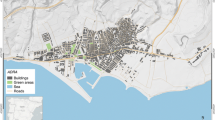Abstract
According to the number of people lost in earthquakes during 20th century as well as in a single (March 4, 1977) earthquake during this century (1574 people, including 1424 in Bucharest), Romania can be ranked the 3rd country in Europe, after Italy and Turkey. Romania is followed by the former Yugoslavia and by the Greece (Bolt 1995, Coburn and Spence 1992).
The World Bank loss estimation after the 1977 earthquake (Report No. P-2240-RO, 1978) indicates that from the total loss (2.05 Billion US $) more than 2/3 was in Bucharest, where 32 tall buildings collapsed. Half of the total loss was accumulated from buildings damage. The 1977 direct loss and indirect consequences of loss mark probably the starting point of economical decay of Romania during the next decade. They also explain the present concern of civil engineers and Romanian Government for assessment and reduction of seismic risk in Romania.
The World Map of Natural Hazards prepared by the Münich Re (1998) indicates for Bucharest: “Large city with Mexico-city effect”. The map focuses the dangerous phenomenon of long (1.6 s) predominant period of soil vibration in Bucharest during strong Carpathians Vrancea earthquakes. The Bucharest and Lisbon are the only two European cities falling into Mexico-city category.
International experts and organizations agreed that Bucharest is the capital city in Europe characterised by the highest seismic risk.
The paper presents:
-
1.
Codes and standards for design of earthquake resistance of structures (1940–2000) and the draft of the new seismic Romanian code P100
-
2.
The structure of existing building stock in Bucharest
-
3.
The most vulnerable to earthquake categories of buildings, located on the soft soil condition of Bucharest
-
tall reinforced concrete buildings in central Bucharest built prior to 1940 and severely damaged by the past 1977 event
-
tall reinforced concrete buildings with soft ground-floor built in Bucharest prior to 1977.
-
4.
Hospitals buildings, university buildings and other buildings, classified as having a high risk of severe damage/collapse in case of a strong earthquake
-
5.
Enlargement of the existing seismic networks of Romania by two recent projects of INCERC and State Inspectorate for Construction and of NCERR and Japan International Cooperation Agency. In the last 6 months in Romania, the two projects provided about 50 (18 in Bucharest) digital Kinemetrics instruments (K2 and ETNA): in free field condition, in deep boreholes as well as in tall buildings.
Similar content being viewed by others
References
ASCE 7–98 2000: ASCE Standard: Minimum design loads for buildings and other structures. American Society of Civil Engineers, New-York, ASCE, SEI
Bolt B 1995: Earthquakes. W H Freeman and Company, New York
Coburn A, Spence R 1992: Earthquake protection. John Wiley and Sons, New York
Constantinescu L, Marza V 1980: Géophysique, 24, 193–206.
Cornea T, Vacareanu R, Lungu D 2000: Technical Report for Collaborative Research Center (CRC) 461 of SFB, Germany: “Strong Earthquakes: A Challenge for Geosciences and Civil Engineering”, Karlsruhe University
Elnashai A, Lungu D 1995: In: Report of the Session A.1.2. 5th International Conference on Seismic Zonation, Nice, Prance, Proceedings Vol. 3, Ouest Editions, Preses Académiques, 2057–2082.
Eurocode 8 — Design provisions for earthquake resistance of structures 1994: Part 1–1: General rules — Seismic actions and general requirements for structures. CEN, European Committee for Standardizatio
HAZUS — Technical Manual 1997: Earthquake Loss Estimation Methodology, Vol. 3.
Hwang H H M, Huo J R 1994: Generation of hazard-consistent fragility curves for seismic loss estimation studies. Technical Report NCEER-94-0015. National Center for Earthquake Engineering Research, State University of New York at Buffalo
Lungu D 1999: Bulletin of the International Institute of Seismology and Earthquake Engineering USEE, Vol. 33, 341–373.
Lungu D, Aldea A 1999: Understanding Urban Risk Around the World. United Nations RADIUS Project at Geohazards Int., Ca., USA. Document City of Bucharest Seismic Profile
Lungu D, Aldea A, Arion C, Cornea T 1998a: In: Second International Conference on Earthquake Hazard and Seismic Risk Reduction, Yerevan, Armenia, Kluwer Academic Publisher, 2000, 281–289.
Lungu D, Demetriu S, Arion C 1998b: In: Vrancea Earthquakes. Tectonics, Hazard and Risk Mitigation. Proc. of First International Workshop on Vrancea Earthquakes, F Wenzel, D Lungu eds, Kluwer Academic Publishers, 215–224.
Lungu D, Cornea T, Nedelcu C 1998c: In: Vrancea Earthquakes. Tectonics, Hazard and Risk Mitigation, F Wenzel, D Lungu eds, Kluwer Academic Publishers, 251–268.
Lungu D, Arion C, Aldea A, Demetriu S 1999: In: NATO ARW Conference on strong motion instrumentation for civil engineering structures, Istanbul, Turkey
Lungu D, Aldea A, Arion C, Demetriu S, Cornea T 2000a: Cahier Technique de l’Association Française du Génie Parasismique, 20, 31–63.
Lungu D, Vacareanu R, Aldea A, Arion C 2000b: Advanced Structural Analysis, Cons-press, UTCB
Lungu D, Arion C, Baur M, Aldea A 2000c: In: 6ICSZ Sixth International Conference on Seismic Zonation, Palm Springs, California, USA, 837–846.
Lungu D, Aldea A, Arion C 2000d: In: Proceedings of the 12th World Conference on Earthquake Engineering, Auckland, New Zealand
Marza V I, Kijko A, Mäntyniemi P 1991: Pageoph, 136, 143–154.
Munich Re 1998: World Map of Natural Hazards
Newmark N M, Hall W J 1982: Earthquake Spectra and Design. Berkeley, Calif. Earthquake Engineering Research Inst.
Radu C 1994: Catalogues of earthquakes occurred on Romanian territory during the periods 984–1990 and 1901–1994 (manuscript)
Văcăreanu R, Cornea T, Lungu D: Evaluation of seismic fragility of buildings, Earthquake Hazard and Countermeasures for Existing Fragile Buildings. D Lungu, T Saito eds, Independent Film, Bucharest. Romania
Wells D L, Coppersmith K J 1994: Bulletin of the Seismological Society of America, 84, 974–1002.
Zanfir A 2000: Assessment of damage buildings. Master thesis (in Romanian), UTCB
Author information
Authors and Affiliations
Corresponding author
Rights and permissions
About this article
Cite this article
Lungu, D., Aldea, A., Demetriu, S. et al. Seismic strengthening of buildings and seismic instrumentation — Two priorities for seismic risk reduction in Romania. Acta Geod. Geoph. Hung 39, 233–258 (2004). https://doi.org/10.1556/AGeod.39.2004.2-3.8
Published:
Issue Date:
DOI: https://doi.org/10.1556/AGeod.39.2004.2-3.8




